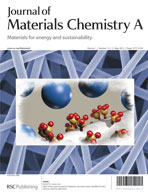Gold nanoparticles immobilized in hyperbranched polyethylenimine modified polyacrylonitrile fiber as highly efficient and recyclable heterogeneous catalysts for the reduction of 4-nitrophenol†
Abstract
Hyperbranched polyethylenimine (HPEI) modified polyacrylonitrile fiber (PANF) was prepared through a water mediated hydrolysis and amidation reaction in an autoclave. The grafting amount of HPEI onto PANF could be modulated conveniently by varying the preparation conditions, such as reaction temperature, reaction time and the feed ratio of HPEI to PANF. The Young's modulus of the PANF decreased with the grafting of HPEI, especially when more HPEIs were grafted. As for the PANF-g-HPEI with low HPEI content, the Young's moduli were similar before and after loading of AuNPs, whereas the loading of AuNPs obviously deteriorated the strength of the fibers with high HPEI content. From the nitrogen adsorption and desorption isotherms, it could be seen that PANF contained nanometer sized pores, and the grafting with HPEI did not affect the pore size, but did reduce the surface area. Moreover, the loading of AuNPs into PANF-g-HPEI also did not influence the pore size, but decreased the surface area. FTIR and XPS analyses demonstrated that the obtained PANF-g-HPEI not only contained a large amount of amino groups from the HPEI moiety, but also many carboxylate ions due to the hydrolysis of the cyano groups of PANF. XRD characterization proved that the inner crystal region of PANF was partially broken by the introduction of HPEI moieties. SEM showed that the PANFs swelled up after grafting with HPEI, and the increase of the grafting efficiency led to a larger average diameter of the fibers. When the grafting amount of HPEI onto PANF reached as high as 97%, the surface of the fibers was severely impaired. The obtained PANF-g-HPEIs could be successfully used as supporters and stabilizers in the preparation of small-sized AuNPs. TEM characterization showed that the mixing time of PANF-g-HPEIs with HAuCl4 aqueous solution affected the size and size distribution of the formed AuNPs, and the optimal mixing time was around 0.5 h. The average diameter of the obtained AuNPs was around 3.0 nm at a feed ratio of amino groups of PANF-g-HPEI to Au atoms ([N] : [Au]) of 200, independent of HPEI content of the PANF-g-HPEIs used. Reducing the [N] : [Au] feed ratio increased the average size of the obtained AuNPs. The AuNPs supported by PANF-g-HPEIs could be used as efficient catalysts for the heterogeneous catalytic reduction of 4-nitrophenol by NaBH4. The PANF-g-HPEI with lower HPEI content endowed the supported AuNPs with a slightly higher catalytic rate. These heterogeneous AuNP catalysts could be conveniently recovered and reused many times, especially the AuNPs supported by the PANF-g-HPEIs containing a low content of HPEI. The turnover number (TON) values of the AuNPs supported by PANF-g-HPEI0.31 and PANF-g-HPEI0.58 could reach more than 5 × 104, which is unprecedented in the catalytic reduction of 4-nitrophenol.


 Please wait while we load your content...
Please wait while we load your content...